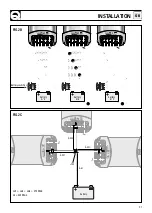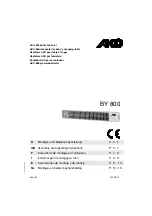
25
OPERATING
GB
BULK phase (constant current) -
The batteries need more current than the battery charger can
supply. Current is limited to the maximum rated output. The battery charger can enter this phase during
start-up, when the batteries are low or when a high load is connected.
ABSORPTION phase (constant voltage) -
The battery charger charges the batteries at a constant
ABSORPTION voltage and at the current they need.
The current needed by the batteries will tend to diminish over time. When the required current is less than
20% of the maximum output value, the charger will change to the FLOAT phase.
With parallel-connected battery chargers, the threshold is the 20% of the sum of the maximum
output currents of the units connected in parallel.
FLOAT phase (maintenance) -
The battery charger charges the batteries at the constant FLOAT volta-
ge. In this phase, as the batteries reach maximum capacity, they will tend to absorb current close to zero
Ampere. This FLOAT phase will allow the batteries to be on charge without the risk of overloading. The
next step to the ABSORPTION phase occurs when the demand for current goes over 20% of the maximum
output value.
With parallel-connected battery chargers, the threshold is the 20% of the sum of the maximum
output currents of the units connected in parallel.
HALF-POWER MODE
If the supply voltage of the equipment drops under 97 Vac the battery charger will activate the “half
power” mode.
In this mode the battery charger can supply, a maximum value half of the maximum nominal output cur-
rent.
In this way you can reduce the current absorption from the AC supply.
This feature is useful when the battery charger is supplied via a generator or from a dock outlet with limi-
ted power output.
The half power mode can be activated manually by using the remote LCD terminal (optional).
CHARGING CHARACTERISTICS
Charging occurs in 3 phases:
(V)
14.1 (28.2) [Gel 14.4 (28.8)]
(I)
Imax
20% Imax
BULK
ABSORPTION
FLOAT
NEW CYCLE
TIME
TIME
13.5 (27.0) [Gel 13.8 (27.6)]
















































